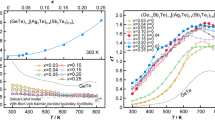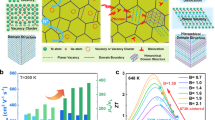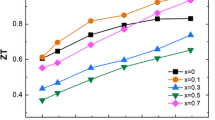Abstract
The IV–VI compound GeTe is considered as a promising alternative to the toxic PbTe for high-efficiency mid-temperature thermoelectric applications. However, pristine GeTe suffers from a high concentration of Ge vacancies, resulting in an excessively high hole concentration (> 1 × 1021 cm−3), which greatly limits its thermoelectric enhancement. To address this issue, CuBiTe2 alloying is introduced to increase the formation energy of Ge vacancies in GeTe, thereby inhibiting the high carrier concentration. The carrier scattering caused by the electronegativity difference between different elements is suppressed due to the similar electronegativity of Cu and Ge atoms. A relatively high hole mobility is obtained, which ultimately leads to a high power factor. Additionally, by introducing Se as an alloying element at the anionic site in GeTe, dense point defects with mass/strain-field fluctuations are induced. This contributes to the strengthening of phonon scattering, thereby reducing the lattice thermal conductivity from 1.44 W·m−1·K−1 for pristine GeTe to 0.28 W·m−1·K−1 for Ge0.95Cu0.05Bi0.05Te0.9Se0.15 compound at 623 K.
Graphical abstract

摘要
IV–VI 化合物GeTe被认为是一种很有前途的, 替代有毒PbTe的高效中温热电材料。然而, 本征GeTe存在高浓度的Ge空位, 导致空穴浓度过高(> 1021 cm−3), 极大地限制了其热电性能。为了解决这一问题, 通过CuBiTe2合金化来增加 GeTe 中Ge空位的形成能, 从而抑制高载流子浓度(nH)。同时由于Cu和Ge原子的电负性相似, 抑制了不同元素之间电负性差异引起的载流子散射, 得到高空穴迁移率(μH), 最终获得了超高功率因子。此外,通过在GeTe的阴离子位置加入Se作为合金化元素, 引入具有质量/应变场波动的致密点缺陷, 极大的加强了声子散射, 在623 K时, 晶格热导率由本征GeTe的1.44 W·m−1K−1降低到Ge0.95Cu0.05Bi0.05Te0.9Se0.15化合物的0.28 W·m−1K−1。最终, Ge0.95Cu0.05Bi0.05Te0.9Se0.15样品在623K时达到最大ZT = ~ 1.87, 在 300–723 K温度范围内, ZTavg显著提高至1.07。本研究成功地优化了GeTe基材料热电传输性能, 为无铅热电材料的探索奠定了坚实的基础。








Similar content being viewed by others
References
Munirathnappa AK, Lee H, Chung I. Recent advances in ultrahigh thermoelectric performance material SnSe. Mater Lab. 2023;2(1):220056. https://doi.org/10.54227/mlab.20220056.
Zhang XY, Bu Z, Lin S, Chen Z, Li W, Pei Y. GeTe thermoelectric. Joule. 2020;4(5):986. https://doi.org/10.1016/j.joule.2020.03004.
Hong M, Li M, Wang Y, Shi XL, Chen ZG. Advances in versatile GeTe thermoelectrics from materials to devices. Adv Mater. 2023;35(2):2208272. https://doi.org/10.1002/adma.202208272.
Boschker JE, Wang RN, Calarco R. GeTe: a simple compound blessed with a plethora of properties. CrystEngComm. 2017;19(36):5324. https://doi.org/10.1039/c7ce01040k.
Hong M, Wang Y, Liu WD, Matsumura S, Wang H, Zou J, Chen ZG. Arrays of planar vacancies in superior thermoelectric Ge1−x−yCdxBiyTe with band convergence. Adv Energy Mater. 2018;8(30):1801837. https://doi.org/10.1002/aenm.201801837.
Weng T, Li Z, Li Y, Hu Y, Guo K, Liu T, Zhang J, Lyu W, Xi L, Yang X, Jiang Y, Yang J, Zhang J, Luo J. Cu vacancy engineering of cage-compound BaCu2Se2: realization of temperature-dependent hole concentration for high average thermoelectric figure-of-merit. Chem Eng J. 2022;437:135302. https://doi.org/10.1016/j.cej.2022.135302.
Zhao Y, Yu P, Zhang G, Sun M, Chi D, Hippalgaonkar K, Thong JTL, Wu J. Low-symmetry PdSe2 for high performance thermoelectric applications. Adv Func Mater. 2020;30(52):2004896. https://doi.org/10.1002/adfm.202004896.
Perumal S, Bellare P, Shenoy US, Waghmare UV, Biswas K. Low thermal conductivity and high thermoelectric performance in Sb and Bi codoped GeTe: complementary effect of band convergence and nanostructuring. Chem Mater. 2017;29(24):10426. https://doi.org/10.1021/acs.chemmater.7b04023.
Shenoy US, Bhat DK. Probing of Bi doped GeTe thermoelectrics leads to revelation of resonant states. J Alloys Compd. 2022;921:165965. https://doi.org/10.1016/j.jallcom.2022.165965.
Srinivasan B, TonquesseS Le, Gellé A, Bourgès C, Monier L, Ohkubo I, Halet JF, Berthebaud D, Mori T. Screening of transition (Y, Zr, Hf, V, Nb, Mo, and Ru) and rare-earth (La and Pr) elements as potential effective dopants for thermoelectric GeTe–an experimental and theoretical appraisal. J Mater Chem A. 2020;8(38):19805. https://doi.org/10.1039/D0TA06710E.
Yin LC, Liu WD, Li M, Wang DZ, Wu H, Wang Y, Zhang L, Shi XL, Liu Q, Chen ZG. Interstitial Cu: an effective strategy for high carrier mobility and high thermoelectric performance in GeTe. Adv Func Mater. 2023;33(25):2301750. https://doi.org/10.1002/adfm.202301750.
Xing T, Song Q, Qiu P, Zhang Q, Gu M, Xia X, Liao J, Shi X, Chen L. High efficiency GeTe-based materials and modules for thermoelectric power generation. Energy Environ Sci. 2021;14(2):995. https://doi.org/10.1039/D0EE02791J.
Jin Y, Wang D, Qiu Y, Zhao LD. Boosting the thermoelectric performance of GeTe by manipulating the phase transition temperature via Sb doping. J Mater Chem C. 2021;9(20):6484. https://doi.org/10.1039/D1TC01714D.
Nshimyimana E, Hao S, Su X, Zhang C, Liu W, Yan Y, Uher C, Wolverton C, Kanatzidis MG, Tang X. Discordant nature of Cd in GeTe enhances phonon scattering and improves band convergence for high thermoelectric performance. J Mater Chem A. 2020;8(3):1193. https://doi.org/10.1039/c9ta10436d.
Xing T, Zhu C, Song Q, Huang H, Xiao J, Ren D, Shi M, Qiu P, Shi X, Xu F, Chen L. Ultralow lattice thermal conductivity and superhigh thermoelectric figure-of-merit in (Mg, Bi) co-doped GeTe. Adv Mater. 2021;33(17):2008773. https://doi.org/10.1002/adma.202008773.
Hong M, Chen ZG, Yang L, Liao ZM, Zou YC, Chen YH, Matsumura S, Zou J. Achieving zT > 2 in p-type AgSbTe2−xSex alloys via exploring the extra light valence band and introducing dense stacking faults. Adv Energy Mater. 2018;8(9):1702333. https://doi.org/10.1002/aenm.201702333.
Liu WD, Wang DZ, Liu Q, Zhou W, Shao Z, Chen ZG. High-performance GeTe-based thermoelectrics: from materials to devices. Adv Energy Mater. 2020;10(19):2000367. https://doi.org/10.1002/aenm.202000367.
Wang DZ, Liu WD, Li M, Zheng K, Hu H, Yin LC, Wang Y, Zhu H, Shi XL, Yang X, Liu Q, Chen ZG. Hierarchical architectural structures induce high performance in n-type GeTe-based thermoelectrics. Adv Funct Mater. 2023;33(14):2213040. https://doi.org/10.1002/adfm.202213040.
Jiang Y, Dong J, Zhuang HL, Yu J, Su B, Li H, Pei J, Sun FH, Zhou M, Hu H, Li JW, Han Z, Zhang BP, Mori T, Li JF. Evolution of defect structures leading to high ZT in GeTe-based thermoelectric materials. Nat Commun. 2022;13(1):6087. https://doi.org/10.1038/s41467-022-33774-z.
Duan S, Xue W, Yao H, Wang X, Wang C, Li S, Zhang Z, Yin L, Bao X, Huang L, Wang X, Chen C, Sui J, Chen Y, Mao J, Cao F, Wang Y, Zhang Q. Achieving high thermoelectric performance by NaSbTe2 alloying in GeTe for simultaneous suppression of Ge vacancies and band tailoring. Adv Energy Mater. 2022;12(3):2103385. https://doi.org/10.1002/aenm.202103385.
Zhou Q, Tan X, Zhang Q, Wang R, Guo Z, Cai J, Ye J, Liu G, Jiang J. Synergistically optimized carrier and phonon transport properties in Bi–Cu2S coalloyed GeTe. ACS Appl Mater Interfaces. 2022;14(40):45621. https://doi.org/10.1021/acsami.2c14636.
Li J, Xie Y, Zhang C, Ma K, Liu F, Ao W, Li Y, Zhang C. Stacking Fault-induced minimized lattice thermal conductivity in the high-performance GeTe-based thermoelectric materials upon Bi2Te3 alloying. ACS Appl Mater Interfaces. 2019;11(22):20064. https://doi.org/10.1021/acsami.9b04984.
Li C, Song H, Dai Z, Zhao Z, Liu C, Yang H, Cui C, Miao L. High thermoelectric performance achieved in Sb-doped GeTe by manipulating carrier concentration and nanoscale twin grains. Materials. 2022;15(2):406. https://doi.org/10.3390/ma15020406.
Zhang Q, Ti Z, Zhu Y, Zhang Y, Cao Y, Li S, Wang M, Li D, Zou B, Hou Y, Wang P, Tang G. Achieving ultralow lattice thermal conductivity and high thermoelectric performance in GeTe alloys via introducing Cu2Te nanocrystals and resonant level doping. ACS Nano. 2021;15(12):19345. https://doi.org/10.1021/acsnano.1c05650.
Jiang B, Wang W, Liu S, Wang Y, Wang C, Chen Y, Xie L, Huang M, He J. High figure-of-merit and power generation in high-entropy GeTe-based thermoelectrics. Science. 2022;377(6602):208. https://doi.org/10.1126/science.abq5815.
Gelbstein Y, Rosenberg Y, Sadia Y, Dariel MP. Thermoelectric properties evolution of spark plasma sintered (Ge0.6Pb0.3Sn0.1)Te following a spinodal decomposition. J Phys Chem C. 2010;114(30):13126. https://doi.org/10.1021/jp103697s.
Liu HT, Sun Q, Zhong Y, Deng Q, Gan L, Lv FL, Shi XL, Chen ZG, Ang R. High-performance in n-type PbTe-based thermoelectric materials achieved by synergistically dynamic doping and energy filtering. Nano Energy. 2022;91:106706. https://doi.org/10.1016/j.nanoen.2021.106706.
Komisarchik G, Gelbstein Y, Fuks D. Solubility of Ti in thermoele-ctric PbTe compound. Intermetallics. 2017;89:16. https://doi.org/10.1016/j.intermet.2017.05.016.
Kaller M, Fuks D, Gelbstein Y. Sc solubility in p-type half-Heusler (Ti1–cScc)NiSn thermoelectric alloys. J Alloy Compd. 2017;729:446. https://doi.org/10.1016/j.jallcom.2017.09.137.
Yin LC, Liu WD, Li M, Sun Q, Gao H, Wang DZ, Wu H, Wang YF, Shi XL, Liu Q, Chen ZG. High carrier mobility and high figure of merit in the CuBiSe2 alloyed GeTe. Adv Energy Mater. 2021;11(45):2102913. https://doi.org/10.1002/aenm.202102913.
Guo Z, Zhang Q, Wang H, Tan X, Shi F, Xiong C, Man N, Hu H, Liu G, Jiang J. Bi–Zn codoping in GeTe synergistically enhances band convergence and phonon scattering for high thermoelectric performance. J Mater Chem A. 2020;8(41):21642. https://doi.org/10.1039/d0ta08700a.
Kim H, Kihoi SK, Shenoy US, Kahiu JN, Shin DH, Bhat DK, Lee HS. High thermoelectric and mechanical performance achieved by a hyperconverged electronic structure and low lattice thermal conductivity in GeTe through CuInTe2 alloying. J Mater Chem A. 2023;11(15):8119. https://doi.org/10.1039/d2ta09280h.
Shportko KV. Disorder and compositional dependences in Urbach-Martienssen tails in amorphous (GeTe)x(Sb2Te3)1–x alloys. Sci Rep. 2019;9(1):6030. https://doi.org/10.1038/s41598-019-42634-8.
Wu D, Xie L, Chao X, Yang Z, He J. Step-up thermoelectric per-formance realized in Bi2Te3 alloyed GeTe via carrier concentration and microstructure modulations. ACS Appl Energy Mater. 2019;2(3):1616. https://doi.org/10.1021/acsaem.9b00057.
Li J, Zhang X, Lin S, Chen Z, Pei Y. Realizing the high thermoel-ectric performance of GeTe by Sb-doping and Se-alloying. Chem Mater. 2017;29(2):605. https://doi.org/10.1021/acs.chemmater.6b04066.
Li J, Chen Z, Zhang X, Sun Y, Yang J, Pei Y. Electronic origin of the high thermoelectric performance of GeTe among the p-type group IV monotellurides. NPG Asia Mater. 2017;9(3):353. https://doi.org/10.1038/am.2017.8.
Li J, Chen Z, Zhang X, Yu H, Wu Z, Xie H, Chen Y, Pei Y. Simultaneous optimization of carrier concentration and alloy scattering for ultrahigh performance GeTe thermoelectrics. Adv Sci. 2017;4(12):1700341. https://doi.org/10.1002/advs.201700341.
Li J, Zhang X, Wang X, Bu Z, Zheng L, Zhou B, Xiong F, Chen Y, Pei Y. High-performance GeTe thermoelectrics in both rhombohedral and cubic phases. J Am Chem Soc. 2018;140(47):16190. https://doi.org/10.1021/jacs.8b09147.
Jin Y, Xiao Y, Wang D, Huang Z, Qiu Y, Zhao LD. Realizing high thermoelectric performance in GeTe through optimizing Ge vacancies and manipulating Ge precipitates. ACS Appl Energy Mater. 2019;2(10):7594. https://doi.org/10.1021/acsaem.9b01585.
Liu Z, Sun J, Mao J, Zhu H, Ren W, Zhou J, Wang Z, Singh DJ, Sui J, Chu CW, Ren Z. Phase-transition temperature suppression to achieve cubic GeTe and high thermoelectric performance by Bi and Mn codoping. Proc Natl Acad Sci. 2018;115(21):5332. https://doi.org/10.1073/pnas.1802020115.
Lyu WY, Liu WD, Li M, Hong M, Guo K, Luo J, Xing J, Sun Q, Xu S, Zou J, Chen ZG. The effect of rare earth element doping on thermoelectric properties of GeTe. Chem Eng J. 2022;446:137278. https://doi.org/10.1016/j.cej.2022.137278.
Lyu WY, Liu WD, Li M, Shi XL, Hong M, Cao T, Guo K, Luo J, Zou J, Chen ZG. Condensed point defects enhance thermoelectric performance of rare-earth Lu-doped GeTe. J Mater Sci Technol. 2023;151:227. https://doi.org/10.1016/j.jmst.2023.01.004.
Wu L, Li X, Wang S, Zhang T, Yang J, Zhang W, Chen L, Yang J. Resonant level-induced high thermoelectric response in indium-doped GeTe. NPG Asia Mater. 2017;9(1):343. https://doi.org/10.1038/am.2016.203.
Ghosh K, Kusiak A, Battaglia JL. Phonon hydrodynamics in crystalline GeTe at low temperature. Phys Rev B. 2020;102(9):094311. https://doi.org/10.1103/PhysRevB.102.094311.
Ghosh K, Kusiak A, Battaglia JL. Effect of characteristic size on the collective phonon transport in crystalline GeTe. Phys Rev Mater. 2021;5(7):073605. https://doi.org/10.1103/PhysRevMaterials.5.073605.
Liu H, Zhang X, Li J, Bu Z, Meng X, Ang R, Li W. Band and phonon engineering for thermoelectric enhancements of rhombohedral GeTe. ACS Appl Mater Interfaces. 2019;11(34):30756. https://doi.org/10.1021/acsami.9b07455.
Zheng S, Xiao S, Peng K, Pan Y, Yang X, Lu X, Han G, Zhang B, Zhou Z, Wang G, Zhou X. Symmetry-guaranteed high carrier mobility in quasi-2D thermoelectric semiconductors. Adv Mater. 2023;35(10):2210380. https://doi.org/10.1002/adma.202210380.
Wang DZ, Liu WD, Shi XL, Gao H, Wu H, Yin LC, Zhang Y, Wang Y, Wu X, Liu Q, Chen ZG. Se-alloying reducing lattice thermal conductivity of Ge0.95Bi0.05Te. J Mater Sci Technol. 2022;106:249. https://doi.org/10.1016/j.jmst.2021.08.020.
Akselrud L, Grin Y. WinCSD: software package for crystallographic calculations (Version 4). J Appl Crystallogr. 2014;47:803. https://doi.org/10.1107/S1600576714001058.
Kresse G, Furthmüller J. Efficient iterative schemes for ab initio total-energy calculations using a plane-wave basis set. Phys Rev B. 1996;54(16):11169. https://doi.org/10.1103/PhysRevB.54.11169.
Blöchl PE. Projector augmented-wave method. Phys Rev B. 1994;50(24):17953. https://doi.org/10.1103/PhysRevB.50.17953.
Lei K, Huang H, Liu XJ, Wang W, Guo K, Zheng RK, Li H. Ultra-low lattice thermal conductivity enables high thermoelectric properties in Cu and Y codoped SnTe via multi-scale composite nanostructures. ACS Sustain Chem Eng. 2023;11(19):7541. https://doi.org/10.1021/acssuschemeng.3c00929.
Jamwal G, Kumar A, Warish M, Chakravarty S, Muthiah S, Kandasami A, Niazi A. Structural, electronic and thermoelectric properties of SnTe with dilute co-doping of Ag and Cu. J Alloy Compd. 2023;954:170182. https://doi.org/10.1016/j.jallcom.2023.170182.
Guo Z, Wu G, Tan X, Wang R, Zhang Z, Wu G, Zhang Q, Wu J, Liu GQ, Jiang J. Enhanced thermoelectric performance in GeTe by synergy of midgap state and band convergence. Adv Func Mater. 2022;33(11):2212421. https://doi.org/10.1002/adfm.202212421.
Bai X, Liu C, Li F, Zhang Z, Peng Y, Si R, Feng B, Wu G, Gao J, Wei H, Miao L. Tailoring 5s2 lone pair-antibonding orbital interaction by Zr-doping to realize ultrahigh power factor in thermoelectric GeTe. Chem Eng J. 2023;461:142069. https://doi.org/10.1016/j.cej.2023.142069.
Liu C, Zhang Z, Peng Y, Li F, Miao L, Nishibori E, Chetty R, Bai X, Si R, Gao J, Wang X, Zhu Y, Wang N, Wei H, Mori T. Charge transfer engineering to achieve extraordinary power generation in GeTe-based thermoelectric materials. Sci Adv. 2023;9(17):0713. https://doi.org/10.1126/sciadv.adh0713.
Li N, He W, Li C, Wang G, Wang G, Zhou X, Lu X. The role of electronegativity in the thermoelectric performance of GeTe–I–V–VI2 solid solutions. J Mater Chem A. 2021;9(4):2385. https://doi.org/10.1039/d0ta10268g.
Yue L, Fang T, Zheng S, Cui W, Wu Y, Chang S, Wang L, Bai P, Zhao H. Cu/Sb Codoping for tuning carrier concentration and thermoelectric performance of GeTe-based alloys with ultralow lattice thermal conductivity. ACS Appl Energy Mater. 2019;2(4):2596. https://doi.org/10.1021/acsaem.8b02213.
Liu Z, Gao W, Zhang W, Sato N, Guo Q, Mori T. High power factor and enhanced thermoelectric performance in Sc and Bi codoped GeTe: insights into the hidden role of rhombohedral distortion degree. Adv Energy Mater. 2020;10(42):2002588. https://doi.org/10.1002/aenm.202002588.
Perumal S, Roychowdhury S, Biswas K. Reduction of thermal conductivity through nanostructuring enhances the thermoelectric figure of merit in Ge1-xBixTe. Inorg Chem Front. 2016;3(1):125–32. https://doi.org/10.1039/c5qi00230c.
Davidow J, Gelbstein Y. A comparison between the mechanical and thermoelectric properties of three highly efficient p-type GeTe-tich compositions: TAGS-80, TAGS-85, and 3% Bi2Te3-doped Ge0.87Pb0.13Te. J Electron Mater. 2012;42(7):1542–9. https://doi.org/10.1007/s11664-012-2316-y.
Samanta M, Biswas K. Low thermal conductivity and high thermoelectric performance in (GeTe)1–2x(GeSe)x(GeS)x: competition between solid solution and phase separation. J Am Chem Soc. 2017;139(27):9382. https://doi.org/10.1021/jacs.7b05143.
Perumal S, Samanta M, Ghosh T, Shenoy US, Bohra AK, Bhattacharya S, Singh A, Waghmare UV, Biswas K. Realization of high thermoelectric figure of merit in GeTe by complementary Co-doping of Bi and In. Joule. 2019;3(10):2565. https://doi.org/10.1016/j.joule.2019.08.017.
Perumal S, Roychowdhury S, Negi DS, Datta R, Biswas K. High thermoelectric performance and enhanced mechanical stability of p-type Ge1-xSbxTe. Chem Mater. 2015;27(20):7171. https://doi.org/10.1021/acs.chemmater.5b03434.
Acknowledgements
This work was financially supported by the National Key Research and Development Program of China (No. 2018YFA0702100), National Natural Science Foundation of China (No. U21A2054). K. Guo acknowledges the support from Key Discipline of Materials Science and Engineering, Bureau of Education of Guangzhou (No. 202255464).
Author information
Authors and Affiliations
Corresponding authors
Ethics declarations
Conflict of interests
The authors declare that they have no conflict of interest.
Supplementary Information
Below is the link to the electronic supplementary material.
Rights and permissions
Springer Nature or its licensor (e.g. a society or other partner) holds exclusive rights to this article under a publishing agreement with the author(s) or other rightsholder(s); author self-archiving of the accepted manuscript version of this article is solely governed by the terms of such publishing agreement and applicable law.
About this article
Cite this article
Wang, XQ., Hu, XQ., Lin, JY. et al. Achieving high carrier mobility and low lattice thermal conductivity in GeTe-based alloys by cationic/anionic co-doping. Rare Met. 43, 2784–2795 (2024). https://doi.org/10.1007/s12598-023-02606-4
Received:
Revised:
Accepted:
Published:
Issue Date:
DOI: https://doi.org/10.1007/s12598-023-02606-4




